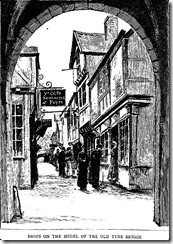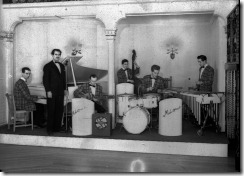
– Posted using MobyPicture.com
Archive for History
Ye Olde
It should by now be common knowledge that the use of Ye, for the, is based on a mistaking of the older orthographic rendering of the word the as Þe. Maybe it’s odd that an almost equally common misreading of ſ – the old long form for s, as an f, hasn’t produced a bunch of Ye olde tea fop from Þe Olde Tea ſhoppe, but the shop’s h probably stops that happening.
But Ye Olde has been around a lot longer than I thought. Here it turns up on the occasion of Queen Victoria’s Diamond Jubilee in 1887. They even had the quainty-wainty f-word (that’s Fayre) back then.
 |
This picture is an engraved illustration from The Graphic (1869 – 1932) of May 21 1887, reporting on the Newcastle Exhibition where they’d had the wherewithal to build a complete half-scale model of the heavily ſhoppe-laden medieval Tyne Bridge which had been washed away in the flood of 1771. Said Jubilee is why Exhibition Park was born, and is also what spawned Newcastle Exhibition Ale |
The Melotones
I thought, from a long time ago when I first knew about my dad’s early career in music, that this band had been called the Mellotones, with two ells. Mellow Tones, of course. But there it is in the pic – just the one. Now I think it should have been pronounced /mi:lotonz/ (a rhyme with me low tones). Or perhaps after the great ancient greek hero /məlɔtəni:z/ (muh-lot-unease). The other greek hero on the right, /vəbrafəni:z/, is being played by m’dad.
The Leith Police

The Leith Special Constabulary of 1916 look like they could dismiss us without too much bother. Tom Archibald’s book on the History of the Lothian and Borders Police doesn’t mention if this particular photograph was ever seen outside the police station – it merely states that it’s an unusual picture. Other group portraits exist which show police in front of a wall sporting earlier (of course, pace Mitch Hedberg) group portraits. I suppose it possible that such photos are taken in places with public displays of police group portraits, but it doesn’t seem very likely.
How the B939 got its Spot
View Larger Map via maps.google.co.uk
Could it be that this Scottish Connection known as St Andrew’s Road, the B939 which connects St Andrews to Ceres (and beyond), was constructed at the behest of one Oliver Gourlay (1740-1819)? According to this snippet (of which there is more here) from “Memorials of the Scottish House of Gourlay“:
In acquiring these and other lands, Oliver Gourlay was led to believe that by a course of high farming he would attain opulence. Ardent in his enterprises, he in 1780 invited the Town Council of St Andrews to construct a superior road between their city and his estate, assuring them that thereby they “would eternize their names.” Impressed by his agricultural activities, capitalists extended to him a large credit, so that prior to 1803 he was enabled to purchase the estate of Kilmaron, near Cupar-Fife, of which the modern rental was upwards of £3000. But Mr Gourlay failed in his agricultural adventures, and disposing of his lands, he retired from public concerns. He died on the 10th October 1819 in his eightieth year.
Though the estate mentioned (Kilmaron) is not in Ceres but is a little north of Cupar, there’s no road from St Andrew’s to Kilmaron. And the road from St Andrew’s through Cupar is a fairly important A road which needs no excuse to be there anyway.
So who was Oliver Gourlay but a distant (and severally-removed) cousin of mine. His grandfather John Gourlay (1678-1723) was (take a breath) my mother’s father’s mother’s mother’s father’s father’s father’s father’s father. Oliver was also the father of Robert Fleming Gourlay – rather well known in Scotland, England and Canada.
Monumental Movies
Tyneside Cinema and Newcastle City are again showing free films, open air, at Grey’s Monument in the run up to christmas.
It’s a big outdoor screen with a bunch of deck chairs on the monument’s south facing (down Grey Street) steps, so if you think it’s gonna rain, bring your own protection. PGs and Us, only. No 15s or 18s of course – it’s in a public place.
If you have a google calendar, feel free to take advantage of my ical connection to get the event times into your own calendar by copying the (ical) link address.
Seems Like Old Times
 Photos from the summer of 1928, from my Great Aunt Lily’s album. She was born on the 20th August 1902 and so is nearly 26 in the four pictures in which she appears. Which are the one with the gentleman friend, the one on the beach with the young lady friend, the one in a quartet aseat on a wall and the one with a gentleman friend on what looks to be a rather dreary day in July,
Photos from the summer of 1928, from my Great Aunt Lily’s album. She was born on the 20th August 1902 and so is nearly 26 in the four pictures in which she appears. Which are the one with the gentleman friend, the one on the beach with the young lady friend, the one in a quartet aseat on a wall and the one with a gentleman friend on what looks to be a rather dreary day in July,
Yore Gala
Here’s a picture – and we know the date it was taken because it helpfully says so in the album whence it was scanned – of a swimming gala held at Tynemouth Pool on the 4th of August 1928. It was probably taken by one of my great aunts or uncles. Maybe Ethel, maybe Lily. or maybe even by their brother Henry my grandfather. We just don’t know.
Arm yourselves
a tumblr chap styled ‘anticapitalist’ once posted:
with knowledge.
People can be shot down. Cities can be burned or gassed. Entire ethnic groups can be destroyed. But an idea, when spread far and wide, can set fire and spread without caring who or what is in its way.
Ideas, when supported by enough people, and spoken loud enough, can change the world.
Speak out, violently if need be.
Never stop the spread of ideas.
It may be the only thing we’ll have left.
Which may take us to the close of Brecht’s ‘To Those Born Later’:
“… Oh, we
Who wanted to prepare the ground for friendliness
Could not ourselves be friendly.
But you, when the time comes at last
And man is a helper to man,
Think of us
With forbearance”


